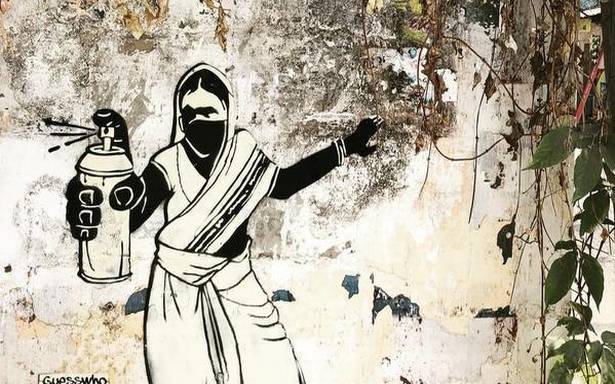ART NEWS
The evolution of street art and graffiti in South India
Street art and graffiti in India inch closer to the mainstream, now being used as tools to brighten cities, transform neighborhoods and bring communities together
“When I painted my first wall without any permission, I waited for the day when it would make it to the news. When my work started getting featured on the news, I decided I wanted to sell my paintings… Tomorrow, the doors open for my solo exhibition and I have nothing more to strike off now,” writes Mumbai-based anonymous artist Tyler in a rather emotional Instagram post addressed to his 67.9K followers on January 13. Tyler’s first solo exhibit in India, currently on display at Method, Bandra and Kala Ghoda, is perhaps a sign that graffiti and street art, largely considered “anti-art”, has found a place in the mainstream. The exhibit literally brings street art into a white cube space shining light on the fact that as much as it is a statement, it is also nothing less than ‘high’ or ‘fine’ art. Public art destinationAbout a year ago, Chennai’s Kannagi Nagar (Off Mahabalipuram Road), one of the largest resettlements in India housing those who have been rehabilitated from river beds and slums, saw a dramatic transformation as 16 artists etched murals on multiple walls, in a bid to make it a public art destination. The art sought to bring the community together. In locations across India, public art welcomed a similiar response as more art destinations cropped up, courtesy St+art India, a non-profit collective that collaborates with governing authorities to drag art out of galleries and into a public space.
Children in front of a mural done by grafitti writer A-Kill in Kannagi Nagar
| Photo Credit: M_Karunakaran
This kind of accessibility and reach that public art provides is what still intrigues budding artists and collectives, despite the risks involved. Celebrated Kochi-based anonymous artist, Guess Who, who is dubbed as ‘India’s own Banksy’ asks, “Isn’t that the beauty of it? It demystifies the aura around art and makes it approachable for everyone.” However, there is a running risk of the work being tampered with. How do artists respond to that? “I would prefer to see the tampering as a response to the artwork or maybe as part of the conversation the art is trying to provide,” Guess Who adds. The artist began commenting on events, political or otherwise, on walls in Fort Kochi, Bengaluru, Chennai and other parts of the country, as early as 2012. By the artist’s own admission, the kind of work they do “technically falls under street art”.In graffiti, however, self expression takes precedence; in fact it is a form of narcissism, opines Chennai-based graffiti writer, A-Kill. “Graffiti is ultimately a call out to the public saying that I exist,” says A-Kill who believes that the art form asserts a certain sense of individuality while street art relies heavily on a narrative.
In the country, however, the inception point of this form of art is difficult to trace. At varied points, around the turn of the 20th Century, is when street culture in India started emerging. But, the starting point of it all is believed to be simple, unassuming wall art mostly used for commercial purposes. Veteran banner artist and art critic V Jeevananthan from Coimbatore remembers seeing his first wall art around 1967 as a child: The wall held lettering and motifs that etched out campaign promises by political parties contesting for elections at the time. “That is the first time I saw a colourful graffiti,” says the artist who recently collaborated with St+art India Foundation to paint a mural in Coimbatore on human/animal conflict. “Wall paintings used to be done widely for commercial and political purposes before that. It was an employment opportunity for many who went around hunting for large walls to paint on, after agreeing upon a contract with the owner. Street art in its true sense, however, is a new trend especially in Coimbatore, perhaps only four years old,” he adds.Rooted in the politicalPolitical writing on public walls seem to be the starting point for street art in Kerala as well. Guess Who adds, “You wouldn’t call it graffiti but their distinctive styles of hand painted letters have a lot of characteristics that are similar to graffiti culture. Unfortunately, there isn’t much of an individual artistic expression.” The artist says that though there are individuals and collectives like Trespassers who paint public walls, there are too few takers for urban art in the State. “The size of it is too negligible for it to be called a collective movement,” says the artist.
One of the walls at Kannagi Nagar art district, Chennai
| Photo Credit: M_Karunakaran
However, it seems like Chennai has a different story to tell. The graffiti culture in the metropolis started picking up around 2014, and was a movement that rose in parallel to the hip hop and b-boying scene. A-Kill who is also part of T3K Collective says, “In Chennai, cinema and politics play a vital role in the societal fabric. For instance, if you go out and paint a wall, people automatically assume that they are political ads or something related to cinema.” But street art is neither. Seven years on, the works are more original, and are actively used to beautify the city, says A-Kill, who had recently finished a mural (65 feet by 903 feet) on the facade of Chennai’s Indira Nagar MRTS, in a bid to create awareness about HIV/AIDS.
“That is what graffiti is moving towards,” he says, adding that a lot of commissioned works for cafes, restaurants and private walls that his crew receives, is testament to the same. Even in events, live graffiti is being commissioned for an “experience”, where people can see artists paint live, almost as though it is a performance. “Now, many young artists are interested in learning the basics; from tagging (signing one’s name) to throwing up (a more elaborate version of the tag with multiple colours and styles) and even piecing (their masterpiece in a legal spot). Whenever they see us paint, they stop to ask us about the work,” says A-Kill, whose crew tries to claim a wall wherever they travel to.Commercial or otherwise, street art is a response to the world around and will continue to be so. Concludes Guess Who, “Like every individual who responds to the realities around them, artists too respond, react and question the world they live in, through their art.”











